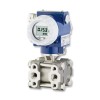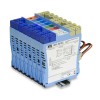Turndown Ratio describes the difference between the highest and lowest possible span of measurement output which can be set for a sensing device with a rangeable output signal such as 4 to 20mA output which is HART enabled.
Turn-down ratio refers to rangeable output devices and indicates how much the output setting can be changed.
e.g. A 10:1 turndown ratio on a 1 bar gauge pressure transmitter would allow the following:
- Highest range setting: 0 to 1 bar absolute = 4 to 20mA
- Lowest range setting: 0 to 100 mbar absolute = 4 to 20mA
Glossary of Measurement Signal technical terms
- 2 Wire
- 3 Wire
- 4 to 20 mA Current Loop Output Signal
- 4 Wire
- Amplified Voltage Output
- BFSG – Bonded Foil Strain Gauge
- Deadband
- FSO – Full Scale Output
- HART®
- mV/V – Millivolts per Volt Output Signal
- NC – Normally Closed
- NO – Normally Open
- Piezoresistive Strain Gauges
- Ratiometric
- Span
- Span Offset
- Span Sensitivity
- Square Root Extraction
- Threshold
- Totalizer
- Transducer
- Transmitter
- TSL – Terminal Straight Line
- TSS – Thermal Span or Sensitivity Shift
- USB
- Vented Cable
- Wheatstone Bridge Strain Gauge
- Zero Offset
- Zero Tare
Help from Measurement Signal resources
- Supply voltage and load resistance considerations for pressure transmitters
- What can cause random variation in pressure transducer output
- What is the difference between zero offset and zero drift?
- Why use 4-20mA and 3-15 psi rather than 0-20mA & 0-15psi




